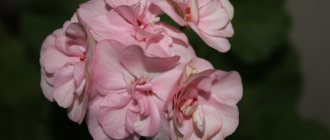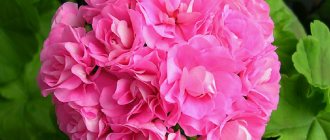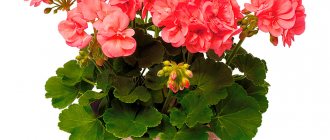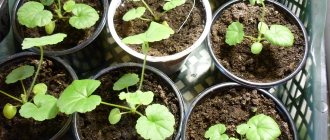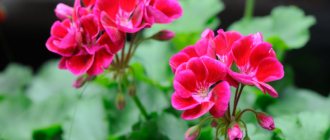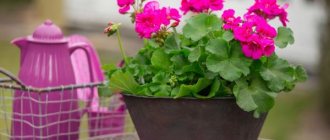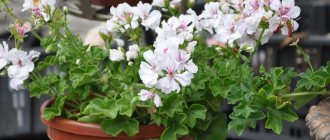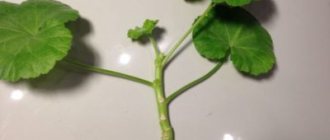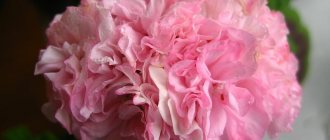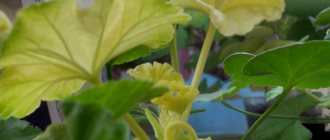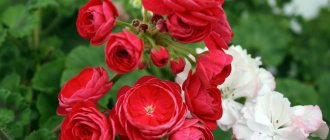As with many plants on our windowsill, the main danger for miniatures is excessive waterlogging. As a result, the root system rots and the plant dies. To prevent this from happening, always use a breathable primer. It would be a good idea to add a little vermiculite or sand to the soil. These two components will prevent excessive waterlogging if this occurs.
Reproduction of dwarf zonal pelargoniums occurs by cuttings. In February-March, when the daylight hours increase, cut a cutting from an adult bush with two internodes (8 cm for miniatures, 10 cm for dwarfs) and dry it for several minutes. When the cut dries, plant the dwarf pelargonium cuttings in fresh, nutritious and breathable soil. It is not worth covering it with a greenhouse on top, so as not to dilute excessive moisture. Place the flowerpot in a bright place. In just a month you will have a young plant. Under favorable conditions, the side shoots will develop compact and soon the pelargonium will delight you with lush flowering.
Sometimes dwarf pelargoniums , such as the Pink Ice variety, have side shoots so small that they have to be cut off with tweezers. For such a cutting, a small plastic cup with soil will be enough. Make sure that the soil in such a small container does not dry out.
When the young plant takes root well and grows, transplant it into a larger pot, but it should be no more than 9 cm in diameter. It is very important. After all, by planting a miniature variety in a large pot, you will provoke its undesirable growth or even rotting of the root system if overwatered.
A month after rooting, young pelargonium must begin to be fed. For this purpose, you will need a universal fertilizer for flowering plants or a special fertilizer for pelargoniums. Apply fertilizer strictly according to the instructions - if there is an excess of it, dwarf pelargoniums grow large leaves, and if there is a deficiency, chlorosis may develop.
For wintering, miniature pelargoniums in the brightest place on the windowsill, water very moderately and only when the substrate dries. There are also variegated miniature pelargoniums in this group. They grow very slowly and are more demanding of heat and light.
Thanks to breeding work, many beautiful varieties of dwarf and miniature pelargonium have been developed. Here are the most beautiful of them.
| Francis Parrett Protect this miniature variety from sudden changes in temperature and the influence of drafts. |
| Pink Ice Very compact pelargonium provided there is sufficient sunlight. |
| Jane Eyre And this variety of pelargonium needs formative pruning. |
| Pensby A dwarf variety of pelargonium with wonderful fluted flowers in the shape of roses. |
Related materials:
- The bright pink, almost red, heavily double buttercup-like flowers of pelargonium PAC Viva Rosita (PAC Viva Rosita) fascinate at first sight not only...
” >Amazingly beautiful pelargonium PAC Viva Rosita – 03-10-2016 08:56 Like many other pelargoniums, miniature and dwarf pelargoniums are increasingly gaining popularity among gardeners. This is explained by the fact that plants...
” >Miniature and dwarf pelargoniums. Growing and care at home - 02/17/2015 02:25 Pelargonium rosebunda has increasingly begun to attract the attention of not only collectors, but also novice amateur gardeners. And all because the color...
” >Rosebud pelargonium: care and reproduction – 12/16/2014 09:22 Royal pelargoniums are generally unpretentious, easy to care for and reproduce. They look great in the apartment, in the office, in balcony boxes and in flowerbeds...
” >Diseases and pests of royal pelargoniums – 02/27/2012 11:39 Royal pelargonium was brought to Europe in the 17th century. from South Africa. The plant was initially grown in the greenhouses of rich people and was considered aristocratic...
Varieties and varieties
There are many varieties of pelargonium, but the zonal species alone has more than 75 thousand varieties and hybrids. Varieties of zonal pelargonium, photos of flowers and their descriptions can be found in color catalogs or in the ranking of the best presented below.
Based on the shape of the flowers, the plant is classified into:
- Non-double.
- Semi-double.
- Terry.
Each variety is attractive and distinctive in its own way. The color scheme is especially pleasing; thanks to it, you can create excellent compositions on your window or flower bed.
- Chandelier violet. In flower growing catalogs, the variety is presented in a solid purple color, but based on reviews from customers who grew the flower from seeds, the shade does not quite match. In reality, the buds bloom in a fuchsia-raspberry hue with a white core, and every day the color becomes more saturated. The shape of the bud resembles a bell.
- Selena -mini. A flower with fiery red double flowers will decorate any garden. The fiery umbrella is framed by thick green leaves with purple-burgundy zoning. The flowering period is long, it can begin to bloom from cuttings.
- Shimmer. The variety is characterized by large, double flowers of bright salmon-coral color with a white core.
- Simonelli. The buds, like angel wings, are white with soft pink veins creating a noble, feminine image.
- Nano scarlet bicolor. The compact bush is densely covered with large, simple flowers of a bright red-crimson hue that will fit perfectly into the overall background of any flower bed. The growth of the bush is 10−15 cm.
- Contrast. Bright red umbrellas, like torches, will decorate the windowsill of a house or the balcony of an apartment. A characteristic feature is considered to be green leaves with a cream border around the edge and dark burgundy zoning in the center.
- Ambrose is the best option for romantic people. The flower is extremely beautiful and can surprise by changing its color. The bud blooms white, gradually becomes pink, and by the end of flowering it fades away again and returns to its original color. Flowering is abundant and long lasting.
- Minx comes in the form of rich red-burgundy umbrellas that are velvety to the touch. The leaves are gray-green with a corrugated edge.
- Alsta Nina for those who love dwarf varieties. The bush is compact and neat; during the flowering period it pleases with flowers of unusual shapes. Semi-double buds change shade from white to pink and back.
- Pelargonium Pavel F 1 attracts attention with its bright pink color with a white core. The bush grows up to 25-35 cm and looks quite neat.
- Raphaella hybrids are usually presented as a mixture of seeds, from which compact bushes grow up to 30 cm in height with fairly large buds. Colors characteristic of hybrids: peach, white, scarlet, lilac, crimson.
- Ungarisk Appleblossom is an original and unusual variety, with densely double inflorescences of a dark burgundy color and a rose-colored form that will not leave any woman indifferent. Large applebloss “roses” will bloom all summer, delighting their owner.
- Colorama is a mixture of pure colors with dense foliage and lush spherical inflorescences growing up to 35-50 cm. Colors in the mixture: salmon, white, red, pink. Flowering duration is from May to October.
- Fandango is a very unusual star pelargonium of dark red color, the upper petals are dissected, similar to antlers.
- The Lucia variety will dilute the geranium collection with a juicy coral shade. The inflorescences are spherical, as if covered with buds, the bush is 35 cm high.
- Askola presents a peach tint series with a delicate white border; the bud is semi-double, but large - up to 4 cm in diameter.
- Pagoda star pelargonium, white with burgundy stamens, looks quite unusual; unlike other varieties, it practically does not look like geranium.
- Melanie is a representative of miniature pelargoniums with a soft peach color. The flower is double and has a light edging along the edge.
- Ungarik appleblossom can surprise with rosaceous inflorescences of a dark burgundy hue. Terry rose-shaped buds will decorate a balcony or kitchen window sill.
- Credo - a standard pelargonium with a double bud of a bright scarlet hue, is familiar to many from childhood.
- Calypso amazing semi-double lilac inflorescences are like a breath of fresh air in a mass of red and coral colors.
- Toscana Merle is a representative of fuchsia shades with a white center. The flower shape is simple.
- Laque - double inflorescences of a juicy coral shade with a white edging and a slightly corrugated edge, from a distance they resemble a bouquet of delicate roses.
- First Yellow will be the golden highlight of the collection. Large yellow balls go well with red, raspberry and salmon tones.
Having chosen zonal pelargonium, it does not matter where it will grow: on a summer cottage or on a windowsill. The flower will delight the eyes of household members and guests. And the ease of growing and caring will make you love the plant even more.
Rules for caring for dwarf pelargonium at home with photos
Nowadays, varieties of pelargoniums such as dwarf or miniature are becoming increasingly popular.
The secret of the demand for these plants lies in their unpretentiousness, compactness and external decorativeness.
In the article we will look at the features of growing dwarf pelargoniums, find out how to plant this plant, and how to care for it at home.
Appearance
Dwarf pelargoniums are a special species: graceful and miniature, they can be located on one windowsill in a picturesque group. To grow the plant, a very small pot is enough - the height of this pelargonium usually does not exceed 15 cm.
But, despite its small size, dwarf pelargonium blooms very beautifully, quite fully. The inflorescences are arranged in groups, forming characteristic caps. The color of the petals varies depending on the variety, but the foliage almost always has a dark, emerald green hue.
Description of the plant
This variety of pelargonium appeared relatively recently. She was bred through selective breeding at the Andrea family nursery in Boston in 1966 . It cannot boast of a wide variety of varieties; there are only about 20 of them.
This is due to the shape of the structure of the flower, or more precisely, the bud, because throughout the entire flowering it does not open completely and the stamens remain practically inaccessible for pollination.
Despite the same shape of the bud structure, the shape and color of the petals can differ significantly from variety to variety : they can have either a smooth or wavy edge, the color on the inside is brighter than on the outside.
Inflorescences are formed by 20–40 buds with 7–9 petals. The stems of pelargonium tulip-shaped are straight, vertically oriented, and can reach a height of 80 cm.
The leaves are either glossy or matte-velvety, but are always whole with a wavy or jagged edge of a rich green color.
Varieties
Let's get acquainted with the most spectacular and popular varieties of this miniature species.
Ludwigsburger Flair
Decorative variety, decorated with delicate pinkish-orange flowers. Despite its external beauty, the variety is quite capricious and requires care.
If the plant does not like the care, pelargonium begins to shed its leaves. Watch a video about pelargonium variety Ludwigsburger Flair:
Spital Dam
A beautiful and at the same time unpretentious variety. The flowers in this case have a delicate pale pink hue, the petals are quite large for a miniature appearance. The inflorescences are collected in decorative lush rosettes.
Francis Parrett
Petals are bright pink, “candy” shade. The plant itself is very compact even for a dwarf type of pelargonium. The variety is quite delicate; the flower must be protected from drafts and sudden temperature changes.
Check out the photo of dwarf pelargonium:
Pelargonium - varieties and types
Pelargonium is a herbaceous, perennial, semi-shrub plant.
There is a more well-known name for this plant - geranium. And very often there is a stereotype that this is a houseplant that grows only in pots on the windowsill. And the appearance is simple red or pink flowers, collected in spherical inflorescences. But this is a very big misconception. The varieties bred today are so diverse and modified in appearance that it is sometimes very difficult to recognize them as the geranium we all know. Below are varieties with descriptions and characteristics. All pelargonium cuttings are well rooted and adapted. You can buy rooted cuttings of pelargonium by calling or writing in advance by email.
Price from 400 rubles.
Landing rules
Let's get acquainted with the basic rules regarding planting dwarf pelargonium.
Lighting and location selection
However, the plant does not tolerate direct rays : at midday, therefore, it is recommended to shade pelargonium. In winter, so that the flower does not lose its decorative effect, it needs to be provided with additional artificial lighting.
In order for the crown of the plant to form compactly, it is recommended to periodically turn the pot towards the window with different sides. This way, the sun's rays will be able to reach all parts of the plant, and the pelargonium will stretch evenly.
Temperature
In summer, pelargonium should be kept in moderate temperatures: +17+23 degrees will be ideal. The plant should not be allowed to overheat. It is better for a flower to overwinter at a temperature of +12-13 degrees, not higher, since at this time the plant should slow down all its vegetative processes and rest.
The soil
Note that dwarf pelargonium is not too demanding on the composition of the soil. The main thing in this case is to provide the plant with good drainage so that the moisture in the pot does not stagnate.
Soils with a neutral or slightly alkaline reaction are best suited for the plant. If the soil is acidic, it is recommended to neutralize it with ash. The recommended substrate composition is as follows:
- part of the humus;
- part of the leaf soil;
- part of the turf;
- part of the river sand.
Geranium flowers stretch over the window frame...
There is Lily, Begonia, Saintpaulia, And geranium has such a name - Pelargonium, But I ask you not to reproach me, I will always call it Gerania!
/Svetlana Sushkova/
Geranium (pelargonium) zonal Salmon
Geranium on the windowsill is a classic of the genre in indoor floriculture, but I think many will agree with me that it has long ceased to be “grandmother’s flower”, thanks to new varieties. Different flower shapes, many colors - red, pink, white, orange, with double-colored petals - indoor geraniums never cease to amaze and delight us!
Description of the plant
Geranium (pelargonium) is a perennial evergreen flowering plant of the Geraniaceae family.
South Africa is considered its homeland, but it has also been found in the wild in India and Australia. The stems of the plant can be straight, branched or creeping. The leaves are simple or dissected, petiolate, covered with villi. They have a spicy aroma due to the presence of essential oils. Their color is mostly green, but there are ornamental plants with variegated foliage.
Flowers of geranium (pelargonium) are small, collected in an umbrella or spherical inflorescence. Each flower most often has five petals, which differ in size. In modern breeding there are varieties whose flowers have 8 or more petals, i.e. are terry.
The coloring varies, but the classic colors are white, pink, and red. Pelargonium with blue flowers does not exist. A plant can simultaneously contain unopened buds, blooming clusters and fading flowers.
The seeds are located in a seed capsule, which, when the seeds ripen, opens and becomes like a stork’s beak - that’s why pelargonium means “stork” in Greek.
A “beak” appeared on the flower - a seed pod
The species and varietal diversity of pelargoniums is so great that it is very difficult to come to a single classification. But still, pelargoniums are most often divided into six types:
- zonal
- ivy-leaved (ampeloid)
- royal
- unique
- deacons
- angels
Pelargonium is zonal. This is the most common species, which has more than 75 thousand varieties.
Pelargonium received this name because on the leaf blade of plants of this species there is a “zone” colored in a different color, most often in the form of a ring or spot in the center. When there is enough sunlight, this zone has a rich color, and when there is a lack of light, it turns pale. "Zone" on a geranium leaf blade
Now the zone has a pale color, but is still clearly visible. In summer the ring was burgundy.
I propose to get acquainted with the varieties of zonal pelargonium (geranium) that I have.
Geranium Dancer White This is a plant with a simple flower shape. Grown from seeds last year.
Paul's pink geranium
Also grown from seeds, but only this season.
Geranium Morning Dawn
Also with simple five-petal flowers, but a slightly different shape. Now grown from seeds.
Geranium Salmon
Also grown from seeds several years ago. A distinctive feature of this variety is that when the flower withers, the petals do not fall off. The withered inflorescence retains its spherical shape. I really love this variety!
Terry geranium
This terry beauty is one of my favorites. Two years ago I bought a small plant at a garden store. Now I have it in triplicate; several more plants were given to relatives and friends. Her petals don’t fall off either. She is the only one of my geraniums that forms “beaks”.
Here is another zonal pelargonium, which differs from others in the number of petals - there are six of them, and they have spots on them.
Mom's geranium
I got it from a rooted cutting from a geranium that Mom had. Mom has been gone for a long time, but her geranium makes me happy with its blossoms, as if saying that our relatives are alive as long as we remember them.
Ads by
Growing conditions
Loves:
- bright but diffuse light
- moderate watering
- regular pruning
Does not love:
- spraying
- overwatering
- drafts
Indoor geranium, compared to other house plants, is very undemanding in terms of growing conditions, but it is worth paying attention to the main points so that the flower does not upset its owner.
Geranium (pelargonium) loves bright light, but it should be diffused. My geraniums stand on southern and southwestern windowsills from October to February. At this time the sun is not hot, and they feel comfortable.
In February, I move them to the table in front of the window - if this is not done, their leaves begin to burn. But they shouldn’t be placed in the depths of the room either - with a lack of light, the shoots stretch out and flowering stops.
At the end of May, I plant all my geraniums in the ground in partial shade. All summer long they delight me and all my relatives with their lush blooms.
Geranium loves moderate watering, but it is better to underwater than to overwater. Spraying is strictly contraindicated for her - high humidity is not for her. Although it tolerates rainy weather when grown outside, the main thing is that there is good drainage.
Geranium loves warmth, because it is not for nothing that it is a native of the African savannas. A comfortable temperature for it is +20…+25, during winter dormancy not lower than +12, but away from hot radiators. Drafts can cause leaves to curl and turn yellow.
Despite the fact that this is a heat-loving plant and does not overwinter in the ground, geranium tolerates short-term frosts calmly and continues to grow and bloom.
Today, on August 29, we had a frost down to -3, my geraniums growing in the ground survived it without tragic consequences.
Planting, transplanting and propagation
For long and lush flowering of geranium, fresh nutritious soil with a predominance of phosphorus-potassium fertilizers is required.
The pot should be of medium size so that the roots are well entwined in the earthen ball. Good drainage is essential. In September I replant the geraniums into pots. I take them a couple of cm in diameter than those in which they grew before planting, because over the summer the roots grow. But, of course, I don’t replace all the pots - I only take a couple of new ones, because not all plants are the same size. If geranium lives only at home, then I do not replant adult plants, I simply change the top layer of soil. I add store-bought soil “For geraniums” or “Universal”. The soil should not be too nutritious, otherwise the greenery will be abundant and the flowering will be poor.
It is worth noting that my geraniums bloom almost all year round, with the exception of one and a half to two months, after pruning in spring and autumn. In winter, flowering, of course, is not as lush as in spring and summer. But if the geranium feels good and blooms, I don’t consider it necessary to interfere with it. As noted above, indoor geranium reproduces well by seeds.
I buy seeds in specialized stores. I usually sow in mid-February and do not use additional lighting. I take store-bought “Rassadny” soil for sowing, add sand and a little charcoal to it. I add a layer of sand to the bottom of the container, then the prepared soil. I spread the seeds 2 cm apart from each other, sprinkle them lightly with soil, moisten them with a spray bottle, cover them with film and put them in a warm place - usually near the stove, where the temperature is about 25 degrees.
Shoots appear within a week. Then I immediately transfer the container to the southern window sill and remove the film. I water the seedlings little by little and infrequently. After two true leaves appear, I plant the plants in small pots - the geraniums grow in them for the first year. I pinch the plants after 5-6 leaves for better tillering. Young geraniums bloom five to six months after germination (depending on the variety).
Waiting for the new season
The second, most popular, quick and easy way to propagate geraniums is cuttings .
Usually for cuttings I use the tops of shoots left over from spring pruning, 8-10 cm long with three leaves. I cut large leaves in half to reduce evaporation. If there is a peduncle, I also trim it. I air-dry the cuttings so that a film forms on the cut and the stem does not rot in the soil.
There are two ways to root cuttings:
- Immediately plant in the ground.
- Place in water until roots form.
I always use the first method.
The main thing here is not to overwater the cutting during rooting, otherwise it will rot. I take the same soil as for growing pelargoniums. The pot is small - 8 cm in diameter. I place the cutting in the soil in the middle of the pot, squeeze it well around the stem so that it does not fall, add a little more soil. The planting depth is no more than 2 cm. I moisten the soil with a spray bottle. I place the pot with the cutting on the table in front of the window so that the light is diffused.
The peculiarity of rooting cuttings of indoor geranium is that they are NOT covered with a cap, like a greenhouse. Rooting occurs in air within two to three weeks. At this time, I simply lightly moisten the soil by spraying water, trying not to get it on the leaves. When the cuttings begin to grow, I move them closer to the window. Usually the percentage of rooting of geranium cuttings is very high.
And although you can take cuttings from a plant all year round, in the spring the cuttings take root better - tested!
Watering and fertilizing
Geranium loves to drink, especially in hot weather, but it should not be over-watered.
I always water the plants as needed when the top layer of soil dries out. Over-drying is just as bad for her as over-watering. With insufficient watering, geranium leaves begin to dry out and fall off, and flowering stops. If it is excessive, the roots may rot or diseases may appear, such as black leg or gray mold. With good drainage, overflow is rare, but the water from the pan must be drained if this happens. Usually in spring and summer I water plants in pots once every two to three days (depending on the weather - the brighter the sun, the more often I water). In the autumn-winter period, watering occurs once every 5-7 days, but our room temperature is +22 and the humidity is 60%. If someone's temperature is higher, you can water more often.
Usually plants are not fertilized in winter, but if my geraniums bloom, then I feed them once a month with liquid fertilizer “For flowering indoor plants.”
After spring pruning in March, I use fertilizer with a predominance of nitrogen so that the green mass grows faster. From April to September I fertilize twice a month with phosphorus-potassium fertilizer or a special one for flowering plants. Of course, all fertilizing is done only after watering!
Features of cultivation
Trimming. Proper pruning is perhaps the main difficulty in caring for zonal pelargonium.
But without this technique you won’t get a neat and well-groomed bush with abundant and long-lasting flowering! I prune this type of geranium twice - in the spring, at the end of February or beginning of March, and in the fall, usually in September. In spring pruning, I completely remove weak shoots and those growing inside the bush. I shorten the remaining ones to 15 cm, immediately giving the bush the desired shape. I use cut shoots for cuttings. I do the pruning with a sharp knife, because... When pruning with pruning shears, the stems can be compressed, and then the cuttings take root worse. During the summer, I pinch off the tops of the shoots that stand out from the overall picture of the neatness of the bushes.
In the fall, I cut out weak shoots, pinch the tops for better tillering, and remove twisted or leafy shoots. I don't do any radical pruning. I always treat the cuts with crushed charcoal.
Thanks to these simple techniques for caring for indoor geraniums, you can admire the blooms of the “queen of indoor floriculture” almost all year round. And if you also consider that the plant has medicinal properties and is used in the perfume and pharmaceutical industries, it becomes obvious what a treasure lives on the windowsills of our apartments!
New items for the season
And in conclusion, I would like to introduce you to the new friends of my geraniums who appeared this season.
In the spring of 2022, they gave me a rooted cutting of Pelargonium ivy-leaved Tuscany Lavender. When it first bloomed, my joy knew no bounds - a double beauty of lavender hue!
Tuscany Lavender
Also in the spring I got Royal geranium. The crowned lady turned out to be very capricious - she has never bloomed yet. I hope to find a common language with her and, as soon as it blooms, I will definitely post a photo here.
Royal geranium is a fastidious person And another geranium bush moved to my windowsill - miniature, with a sprout of 15 cm in total, but already with buds. I just can’t determine which subspecies this geranium belongs to - star-shaped, cactus-shaped or carnation-shaped? If anyone recognizes her, I would be very grateful for the information!
Who are you, young lady, tell me? This small collection of pelargoniums - indoor geraniums - has been decorating the windows of our house in winter and flower beds in summer for several years now... Summer is still far away, but for now...
It's snowing... It's snowing... Geranium flowers are reaching out to the white stars in the snowstorm Over the window frame...
/Boris Pasternak/
Home care
Let's look at the basic recommendations for caring for this miniature plant.
Watering
This plant must be provided with moisture regularly and in sufficient quantity. In summer, it is better to water every other day, and in winter, the number of waterings should be reduced to once a week. It is not recommended to allow excessive moisture: the soil should be dry before the next watering.
Carefully loosen the soil after each watering , since regular and sufficient oxygen access to the roots is very important for dwarf pelargonium.
Dwarf pelargonium does not need spraying: this procedure can only damage its foliage and flowers.
Top dressing
The plant needs regular additional nutrition throughout the growing season from March-April to October-November. In winter, dwarf pelargonium is not fed, giving it time to rest.
The plant especially needs phosphorus and potassium , but you need to be careful with nitrogen: with an excess of this microelement, the green mass of dwarf pelargonium actively grows, but flowers are in no hurry to form.
Molding
In order for the bush to please the eye with its splendor, it is necessary to regularly pinch the young shoots. This measure will allow the plant to form a larger number of lateral branches, and its overall decorative effect will thus only benefit. Additionally, we note that to form a dense compact bush of good shape, it is recommended to grow dwarf pelargonium in spacious containers, although it will bloom better in cramped ones.
It happens that during the winter some shoots stretch out quite significantly compared to others. With the onset of spring, it is recommended to shorten such “vigorous” specimens by a third of their height. If the cuttings cut during molding are healthy and strong, they can be rooted. Thus, your farm will add more beautiful graceful pelargoniums.
What you need to know about care
Caring for Salmon pelargoniums involves implementing standard agrotechnical practices.
Watering
Pelargonium Salmon needs moderate watering. It is advisable to water 1-2 times a week. Excess moisture negatively affects the plant. For irrigation you need to use soft and settled water. If water gets on the leaves and petals, it can cause burns.
Feeding
During the flowering period, plants prefer phosphorus-potassium fertilizers. You can use liquid fertilizers or add a long-acting dry granular fertilizer to the soil when planting. In this case, you will not have to worry about regularly feeding your flowers.
When purchasing fertilizer, pay attention to the content of microelements in the mixture. The following are especially important for the plant:
- magnesium;
- zinc;
- iron;
- iodine.
Plants require nitrogen in minimal quantities when buds have not yet formed on the bushes.
Temperature
In summer, Salmon prefers an air temperature of no more than +25 degrees. In winter, the best conditions are a cool, draft-free room with a temperature of +18 to +15 degrees.
Trimming
In order for the plant to be beautiful and lush, it is necessary to give it the desired shape by pinching the tops of young shoots or cuttings.
Diseases and pests
Let's find out what diseases and harmful insect parasites can threaten this plant.
So, the most dangerous pests are aphids, spider mites and whiteflies. Special formulations with fungicides can cope with these harmful insects.
Dwarf pelargonium is susceptible to a disease called “black leg”. This is root rot that affects the plant as a result of excessive soil moisture and insufficiently high air temperatures. Note that blackleg cannot be treated: the diseased plant must be disposed of. The soil remaining in the pot after disposal of the plant can no longer be used in floriculture: it must also be disposed of.
Excessive watering can also lead to swelling on the leaves and their rotting. And too low a temperature can lead to reddening of the foliage. To prevent this from happening, on frosty, cold days, move the pot away from the window glass.
With a lack of light, the stems of the plant stretch out and become bare. Solving this problem is simple: you just need to place the pot of pelargonium in its proper well-lit place. If the plant does not bloom, the reason for this may be that the air temperature is too high when the plant overwinters.
Origin and characteristics of the flower
When growing a flower, do not forget where it comes from and what conditions it needs, otherwise there will be no full flowering and manifestation of varietal qualities.
Pelargonium zonale is a herbaceous perennial plant belonging to the Geraniaceae family. Its homeland is considered to be South Africa, from where it was brought to Holland, and then it spread throughout Europe due to its attractiveness and unpretentiousness. The name "pelargonium" translates as "stork's beak". Indeed, the fruits of the plant resemble the shape of a bird's beak.
External description
The standard flower is considered to be a tall, lush green shrub with round leaves and bright flower caps. Features of the plant:
- The stem is smooth and reaches a height of up to 90 cm in a pot and over 1 meter in natural conditions. In addition to tall representatives, there are creeping and dwarf varieties.
- The leaves of pelargonium are simple, palmate from light to rich green in color, with a characteristic burgundy edging visible in the center. It is because of her that the species got its name. The pattern may appear more pronounced in hot weather, in bright light, or disappear completely in the cold season.
- The flowers are simple, consisting of 5 petals. The inflorescences are collected in tall umbrellas with more than 15-20 buds on each. According to their shape, flowers can be divided into simple, semi-double and double (more than 8 petals).
- The shade range is wide and includes all the colors of the rainbow.
When touched, the plant emits an unusual aroma, and some may find it unpleasant, but breeders have tried and corrected this flaw: now the aroma of the flower can resemble the smell of fruits or herbs.
Medicinal properties of the flower
In addition to its beauty and attractiveness, the flower has medicinal properties and is widely used in folk medicine:
- The African plant is considered an excellent filter. Possessing a bactericidal effect, it purifies the air from bacteria and germs.
- Geranium oil and extracts are extracted from pelargonium, which are used in perfume and cosmetic production.
- To relieve migraine pain or reduce blood pressure, tea is prepared from the leaves.
- Tea helps in the fight against insomnia, and a fresh leaf, rubbed with your fingers, will help with toothache and when teething in babies.
Tinctures, decoctions, juice from the leaves of other types of pelargonium (fragrant, pink, saddle) help with various diseases, burns and injuries.
Reproduction
Note that the bush is able to maintain its decorative effect for two to five years, after which it is recommended to replace it with a more recent specimen. A full-fledged plant from a cutting will grow in about a year - so take care of the “growing replacement” in advance.
The plant propagates by cuttings. To carry out this procedure correctly, it is recommended to cut the cuttings in February-March: use the apical part of the mother plant.
Then the cut must be dried for several minutes and, without immersing it in water, immediately planted in prepared loose nutritious soil. Do not cover the top with anything, so as not to create a greenhouse effect and not to over-water the plant. The container must be placed in a sunny, bright place - and in about a month you will already have young dwarf pelargonium. Cuttings root best at a temperature of +20+22 degrees and with regular watering
After the flower has taken root and 8-10 leaves have formed on it, the first pinching is carried out. The procedure will help the plant grow in breadth and become compact. The next pinchings are carried out on the side shoots, when, in turn, they will have 8-10 leaves. And, although cuttings planted in the spring can bloom in the same summer, in the first year experienced gardeners recommend directing all efforts to forming a proper compact bush - and then the next year the flowering will be simply amazing.
Pelargonium should not be propagated in winter, since at this time the plant is in hibernation, all processes in it are inactive, and the cutting may not take root at all.
Spital Dam
| VKONTAKTE COMMUNITY |
| Flowers by train! |
Sending by train is possible to all cities if there is a direct connection from Tyumen to your city!
Year-round delivery of orders to the following cities:
Astrakhan, Baku, Vladivostok, Vladimir, Volgograd, Vyazma, Yekaterinburg, Irkutsk, Ishim, Kazan, Kamensk-Uralsky, Kemerovo, Kirov, Krasnoyarsk, Makhachkala, Megion, Miass, Minsk, Moscow, Nizhnevartovsk, Nizhny Novgorod, Novosibirsk, Omsk, Penza , Pervouralsk, Perm, Rostov, Samara, St. Petersburg, Saratov, Smolensk, Sochi, Surgut, Syzran, Tobolsk, Tomsk, Ulan-Ude, Ulyanovsk, Ufa, Khabarovsk, Chapaevsk, Chelyabinsk, Chita.
NEW Baby sets on sale:Violets – 10 children at a price of 1400 rubles. together with postage (without postage 1000 rub.).
Pelargoniums – 5 pieces 1000 rub. (without postage)
In the sets, children are selected at my discretion, different in color.
SPECIAL OFFERfrom 01/08/2018
Please keep track of the sale of children, starters, divisions, adult violet plants and pelargonium cuttings
| COMMUNICATION ON THE SITE |
Good luck in growing. Alena February 06, 2022, 21:48 // Guest book –
I want to say a big thank you to Alena for the wonderful children. All so beautiful, juicy and strong. Svetlana February 06, 2022, 12:32 // Guest book –
Of course you can, email the list. Alena July 26, 2022, 08:15 // Contacts – Flower Paradise
Thank you, Lyudmila! Good luck in growing. Alena July 26, 2022, 08:15 // Guest book –
Article rating:
Pelargonium spital dam Link to main publication
Related publications
- Geranium seedlings
- Pelargonium kiri
- Eskay verglo pelargonium
- red geranium
- Geranium pruning
- Pelargonium chandelier
- Why do geranium leaves turn white?
- Pelargonium paul west
- Eric hoskins pelargonium
- Pelargonium edwards blanche
- Soil for pelargonium composition
- Pelargonium growing from seeds
